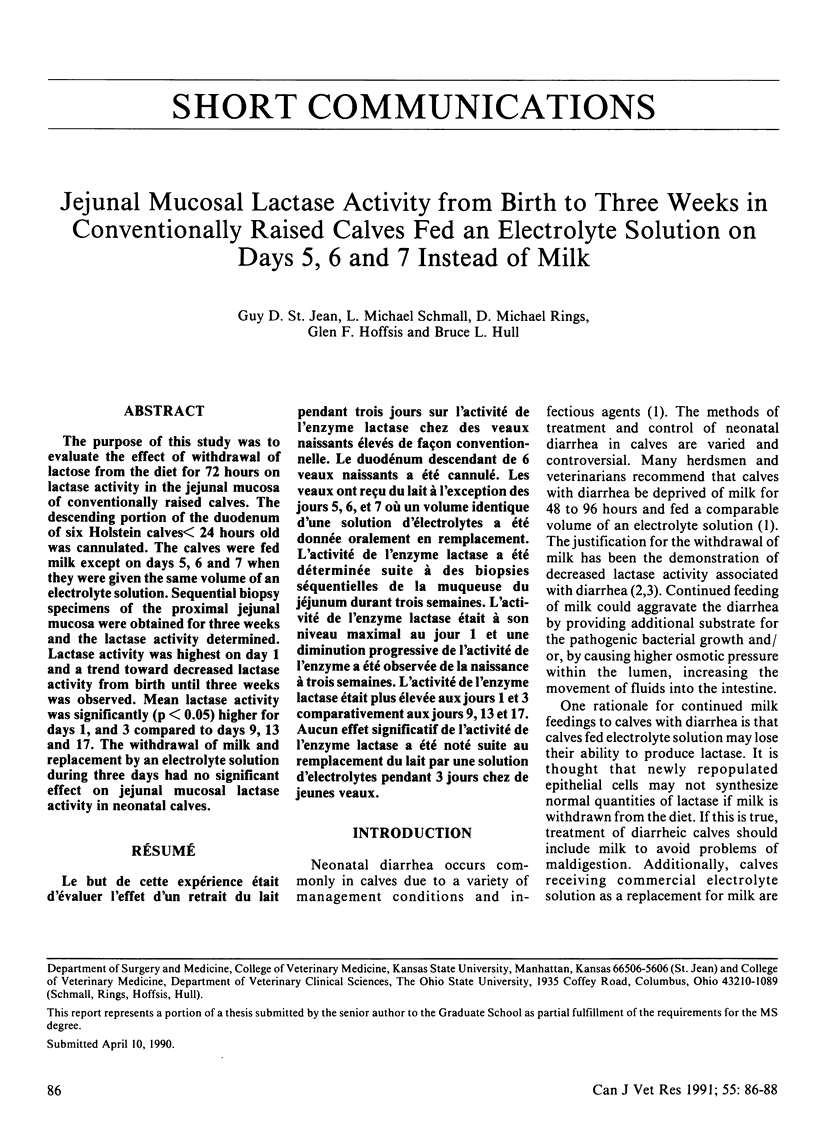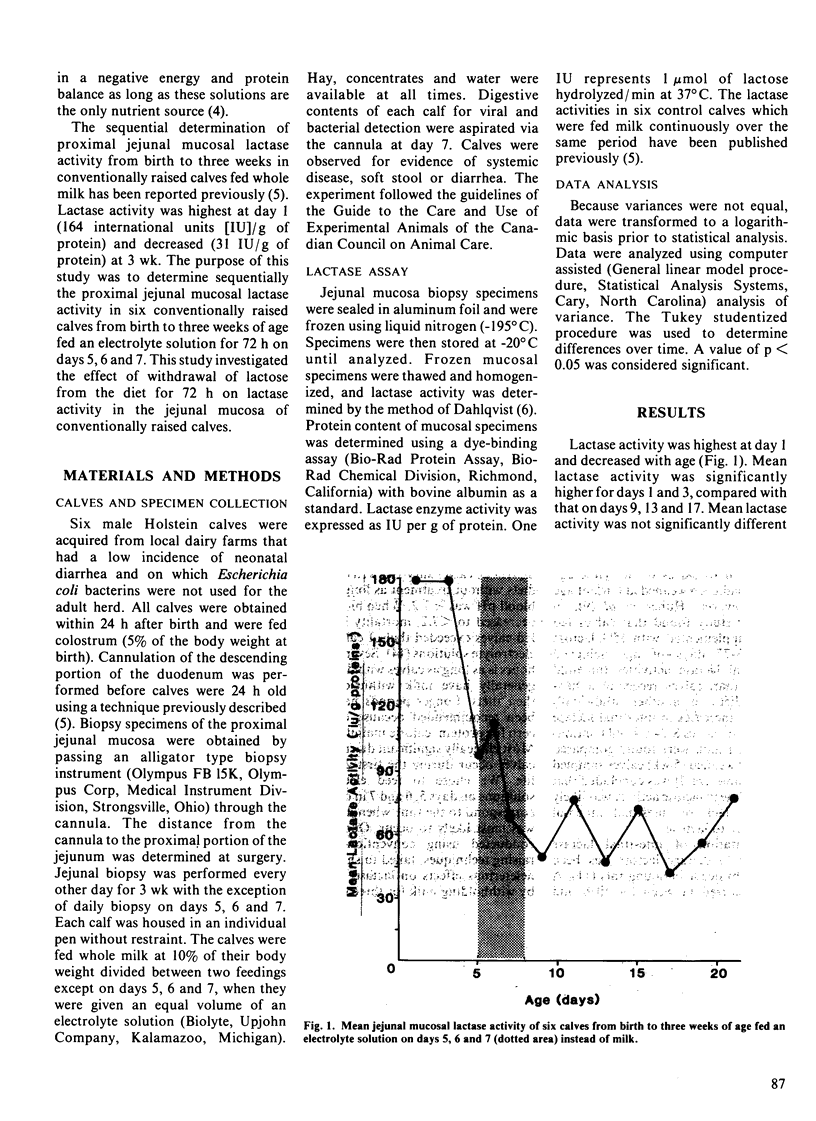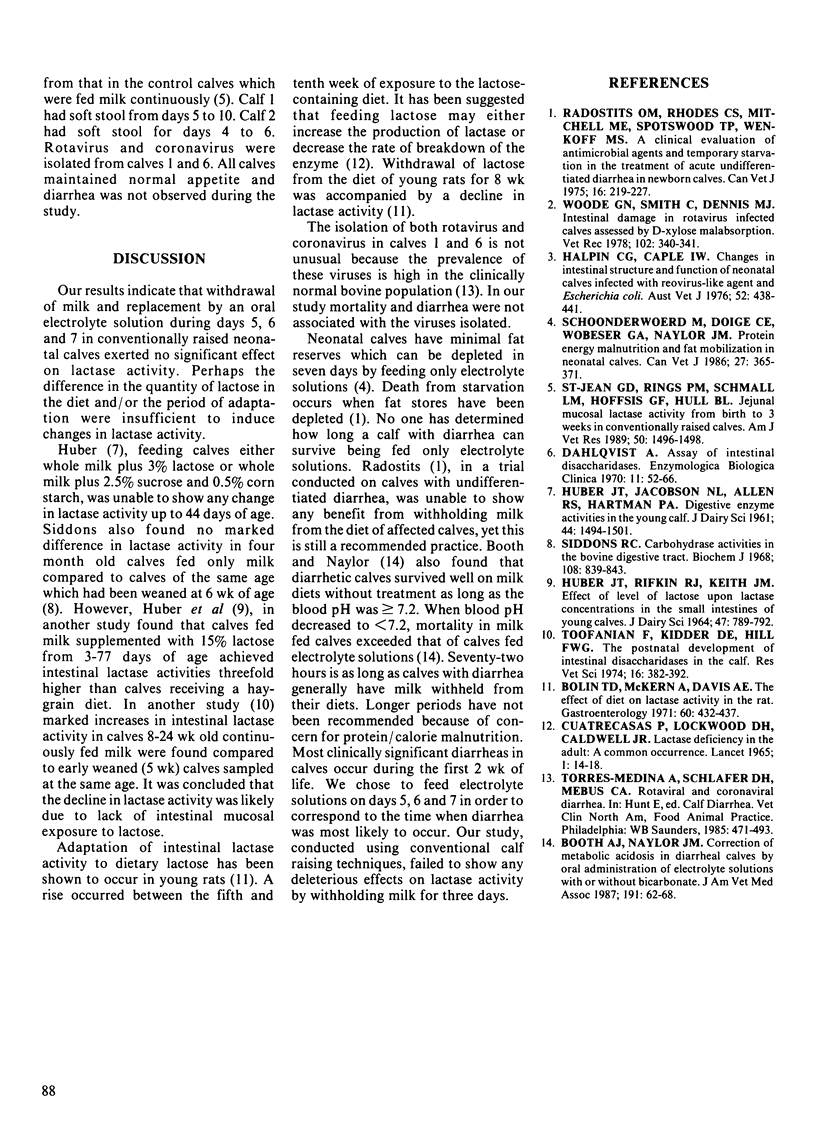Abstract
The purpose of this study was to evaluate the effect of withdrawal of lactose from the diet for 72 hours on lactase activity in the jejunal mucosa of conventionally raised calves. The descending portion of the duodenum of six Holstein calves less than 24 hours old was cannulated. The calves were fed milk except on days 5, 6 and 7 when they were given the same volume of an electrolyte solution. Sequential biopsy specimens of the proximal jejunal mucosa were obtained for three weeks and the lactase activity determined. Lactase activity was highest on day 1 and a trend toward decreased lactase activity from birth until three weeks was observed. Mean lactase activity was significantly (p less than 0.05) higher for days 1, and 3 compared to days 9, 13 and 17. The withdrawal of milk and replacement by an electrolyte solution during three days had no significant effect on jejunal mucosal lactase activity in neonatal calves.
Full text
PDF


Selected References
These references are in PubMed. This may not be the complete list of references from this article.
- Bolin T. D., McKern A., Davis A. E. The effect of diet on lactase activity in the rat. Gastroenterology. 1971 Mar;60(3):432–437. [PubMed] [Google Scholar]
- Booth A. J., Naylor J. M. Correction of metabolic acidosis in diarrheal calves by oral administration of electrolyte solutions with or without bicarbonate. J Am Vet Med Assoc. 1987 Jul 1;191(1):62–68. [PubMed] [Google Scholar]
- CUATRECASAS P., LOCKWOOD D. H., CALDWELL J. R. LACTASE DEFICIENCY IN THE ADULT. A COMMON OCCURRENCE. Lancet. 1965 Jan 2;1(7375):14–18. doi: 10.1016/s0140-6736(65)90922-0. [DOI] [PubMed] [Google Scholar]
- Dahlqvist A. Assay of intestinal disaccharidases. Enzymol Biol Clin (Basel) 1970;11(1):52–66. [PubMed] [Google Scholar]
- Halpin C. G., Caple I. W. Changes in intestinal structure and function of neonatal calves infected with reovirus-like agent and Eschericia coli. Aust Vet J. 1976 Oct;52(10):438–441. doi: 10.1111/j.1751-0813.1976.tb05384.x. [DOI] [PubMed] [Google Scholar]
- Radostits O. M., Rhodes C. S., Mitchell M. E., Spotswood T. P., Wenkoff M. S. A clinical evaluation of antimicrobial agents and temporary starvation in the treatment of acute undifferentiated diarrhea in newborn calves. Can Vet J. 1975 Aug;16(8):219–227. [PMC free article] [PubMed] [Google Scholar]
- Schoonderwoerd M., Doige C. E., Wobeser G. A., Naylor J. M. Protein energy malnutrition and fat mobilization in neonatal calves. Can Vet J. 1986 Oct;27(10):365–371. [PMC free article] [PubMed] [Google Scholar]
- Siddons R. C. Carbohydrase activities in the bovine digestive tract. Biochem J. 1968 Aug;108(5):839–844. doi: 10.1042/bj1080839. [DOI] [PMC free article] [PubMed] [Google Scholar]
- St Jean G. D., Rings D. M., Schmall L. M., Hoffsis G. F., Hull B. L. Jejunal mucosal lactase activity from birth to 3 weeks in conventionally raised calves. Am J Vet Res. 1989 Sep;50(9):1496–1498. [PubMed] [Google Scholar]
- Toofanian F., Kidder D. E., Hill F. W. The postnatal development of intestinal disaccharidases in the calf. Res Vet Sci. 1974 May;16(3):382–392. [PubMed] [Google Scholar]
- Torres-Medina A., Schlafer D. H., Mebus C. A. Rotaviral and coronaviral diarrhea. Vet Clin North Am Food Anim Pract. 1985 Nov;1(3):471–493. doi: 10.1016/S0749-0720(15)31297-4. [DOI] [PMC free article] [PubMed] [Google Scholar]
- Woode G. N., Smith C., Dennis M. J. Intestinal damage in rotavirus infected calves assessed by D-xylose malabsorption. Vet Rec. 1978 Apr 15;102(15):340–341. doi: 10.1136/vr.102.15.340-a. [DOI] [PubMed] [Google Scholar]


